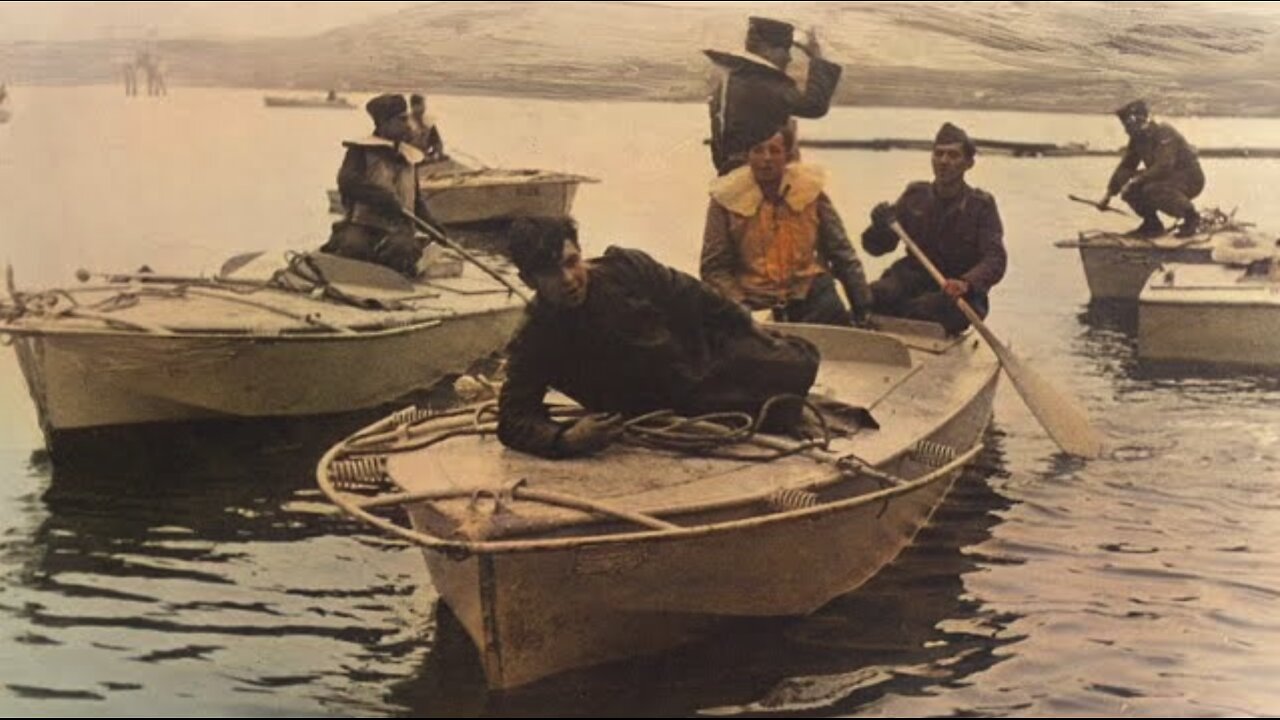Premium Only Content

Did the Germans use SUICIDE BOATS against the Allies in 1944? The evidence some GIs found ...
🔥PREVIEW ALL YOUTUBE VIDEOS
www.Patreon.com/Military1945
Episode 223
SIGNAL 1944 & 1945 for sale...
https://www.militaria1945.com/signal-1944-complete-p-38350.html
Here In episode 223 we’ll take a look at the German Blasting boat which came into service just after the Normandy invasion.
From this periodical we’ll go through an article which covers these boats and see some German Navy footage which shows exactly how this new weapons platform was used. Then we’ll see some footage taken by American soldiers just after the German capitulation which shows how they were secretively assembled and what the American GI’s had believed that they’d found. As that rare footage rolls I’ll provide a more technical description of the boats characteristics so stick around, it’s worth it, I promise.
The title reads, Mit der Geschwindigkeit eines… With the speed of a fast car, the blasting boat races towards the enemy target
The invasion on the Normandy coast has lead to a concentration of enemy war and transport ships. Their proximity to the coast makes engaging these targets with traditional war ships and submarines difficult. In response, speed boats and improvised craft are being used with totally new combat methods. These speed boats along with the one-man-torpedo have shown themselves to be effective.
Specifically, these small wooden boats are in fact modified race boats. They have the speed, are built in a similar manner and can be launched basically from any location along the coast. Around the top edge of the front of the boats deck, which can be seen easily in the photo to the left, is a mechanical frame structure which is connected to the boats explosive charge. When the boat is aligned and racing towards its target, the pilot can flip a switch which arms the triggering mechanism. When it collides with the target the charge of hundreds of kilos detonates. The explosive charge makes up about a quarter of the total weight of the boat.
The power of the explosion is able to defeat pretty much any enemy target. In addition to its speed, at night the boats are very difficult to spot. Its manoverability gives the boat’s pilot the opportunity to choose its attacking angle and so reduce enemy’s ability to take defensive action.
Along with the blasting boats, a command boat is present with an officer who chooses the targets and generally organizes the attack. When the boat is in position for a combat run the pilot activates the charge, locks the steering mechanism and then flings himself backwards into the water. The officer in the command boat is then able to steer the now unmanned blasting boats by radio control into their targets.
The command boat that has stayed back during the attack retrieves the pilot. The blasting boats, now unmanned, were steered to the targets by the command boat by radio control.
In the photo to the right, we see the moment the pilot, after completing his run, has been picked up out of the water by the command boat. Under his leather suit the pilot wears a wetsuit that keeps him warm in the water. He has life vest, a signal torch that can be easily seen at night and even carries emergency rations.
Sprengboot
This American footage was taken in May of 1945. As we can see by the film’s title, the Americans believed that these boats were meant to be piloted by suicide pilots. Like the Me-262 these boats were assembled in unusual locations, for example here in a forested area, to avoid allied bombing.
By October 1944, 385 of the light explosive boat type Linse had been manufactured. The cruising range was 100 nautical miles at a speed of 15 knots.
The purpose of the Linse was for the pilot to approach a targeted ship head-on at full speed and then jump off the boat about 300 meters away. The metal springed frame that ran around the bow of the ship didn’t actually trigger the main charge but rather a 3-7 second delay fuse. On impact the Linse itself sank immediately due to its light but rear-heavy construction. Finally the delay fuse would detonate the main charge under the target’s hull to ensure maximum damage. The main charge located at the stern initially consisted of 300 kg and later 480 kg of explosives.
The overall success of the Linse was poor. Ships were damaged, but no Allied ships were sunk. A spectacular success was Operation Bruno in September 1944, in which combat swimmers used lenses to blow up the lock gates of the port of Antwerp. As a result, the port was unable to serve as an Allied logistical hub for months.
-
 8:31
8:31
Military1945
2 days agoGerman French cooperation 1943 policy and propaganda - Molin Rouge Cabaret - Allied bombing in Paris
46 -
 2:12:58
2:12:58
Robert Gouveia
13 hours agoSenator's Wife EXPOSED! Special Counsel ATTACKS; AP News BLOWN OUT
108K41 -
 55:07
55:07
LFA TV
1 day agoDefending the Indefensible | TRUMPET DAILY 2.25.25 7PM
33.7K20 -
 6:09:26
6:09:26
Barry Cunningham
20 hours agoTRUMP DAILY BRIEFING - WATCH WHITE HOUSE PRESS CONFERENCE LIVE! EXECUTIVE ORDERS AND MORE!
174K76 -
 1:46:37
1:46:37
Game On!
14 hours ago $7.27 earnedPUMP THE BRAKES! Checking Today's Sports Betting Lines!
51.6K3 -
 1:27:21
1:27:21
Redacted News
14 hours agoBREAKING! SOMETHING BIG IS HAPPENING AT THE CIA AND FBI RIGHT NOW, AS KASH PATEL CLEANS HOUSE
198K245 -
 1:08:28
1:08:28
In The Litter Box w/ Jewels & Catturd
1 day agoCrenshaw Threatens Tucker | In the Litter Box w/ Jewels & Catturd – Ep. 749 – 2/25/2025
116K64 -
 44:57
44:57
Standpoint with Gabe Groisman
1 day agoWill Byron Donalds Run for Florida Governor? With Congressman Byron Donalds
76.3K10 -
 1:06:25
1:06:25
Savanah Hernandez
13 hours agoEXPOSED: FBI destroys evidence as NSA’s LGBTQ sex chats get leaked?!
81.9K38 -
 1:59:58
1:59:58
Revenge of the Cis
15 hours agoEpisode 1452: Hindsight
68.7K13